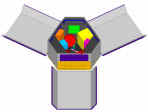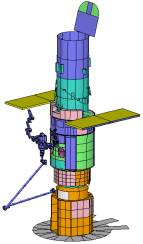Nicholas M. TetiP.O. Box 192 Grasonville, Maryland
21638 Email: nick@thermalengineer.com Phone: (301) 802-1870 |
|||
AEROSPACE/THERMAL ENGINEER |
|||
|
EXPERIENCE |
|||
|
1989-PRESENT |
ATK/SWALES AEROSPACE, BELTSVILLE, MARYLAND |
||
|
|
Senior Thermal Engineer,
Manager, Thermal Systems Engineering |
||
|
JOB RELATED DUTIES: |
·
Specify Passive and Active Thermal Control System (TCS) for
spacecraft and instruments |
||
|
·
Prepare and present all phases of thermal design at design reviews
and in proposals |
|||
|
·
Select and procure
thermal flight and test hardware, thermal coatings and materials |
|||
|
·
Perform electronic
component and circuit board thermal design and analysis |
|||
|
·
Extensive knowledge of thermal software: SINDA, TRASYS, TSS, SSPTA
and Thermal Desktop |
|||
|
·
Develop and support TV/TB test plans, procedures and launch ops for
ELV and Shuttle missions |
|||
|
·
Develop and manage tasks, schedules, cost analysis, test plans,
procedures and work orders. |
|||
|
·
Thermal Systems Engineering Management Responsibilities |
|||
|
o
Promoted to Manager in 3/2006 (Asst. Mgr. 2002-2006) |
|||
|
o
Review and provide direction for Performance Appraisals and
Development Plans |
|||
|
o
Manage and monitor task assignments including manpower updates and
projections |
|||
|
o
Provide technical direction to junior engineers and project
engineering teams |
|||
|
o
Hiring
Manager (Experienced, New Grads and Co-ops) |
|||
|
|
|
||
|
2/02-PRESENT |
Tracking Data & Relay Satellite System (TDRSS) Thermal Support · Thermal Subsystem
Flight Readiness Review Team ·
On-orbit thermal
subsystem performance evaluation and trending analysis for TDRS H, I, J ·
Deployments and
acquisitions support from White Sands, NM for TRDS-I, J ·
TRDS-I anomoly evaluation team team member ·
TRDS-J pre-flight visual inspection of thermal hardware ·
TRDS-I, J on-orb · Monitor and provide thermal status for all TRDS satellites |
|
|
| 9/05 - PRESENT |
Operationally Responsive Spacecraft Modular Bus (ORSMB/TacSat-3) · Thermal System Lead for Phase I – Sr. oversight for Phase II · Jr. Thermal Engineer oversight · Presented PDR thermal design to AFRL · Thermal DesktopTM and SINDA/FLUINT thermal models ·
Supported development of Plug-N-Play 1-Wire temperature sensor |

|
|
| 9/04-PRESENT |
HST SM4 Support - Crew Aid Tools (CATS) and Testing Support · Review panel member for CATS PDR and CDR. · Thermal Vacuum qualification support
HST Robotic Servicing and De-Orbit Mission (HRSDM) ·
Lead thermal systems engineer in
the thermal design, analysis and coordination of the HST Robotic Vehicle (HRV)
system. ·
Oversight of more than 20 thermal
engineers. ·
Coordinated delivery and
evaluation of the HST, De-Orbit Module (DM), Ejection Module (EM), Robotic
System (RS) and Science Instruments (SI) detailed and reduced Thermal Desktop
(TD), Thermal Synthesis System (TSS) and SINDA thermal models. ·
Interface with NASA engineers,
contractor engineers, support system level meetings, system requirement
reviews, design reviews and peer reviews as required. ·
Support the management,
definition, documentation and review of lower level requirements for the
interface control documents. ·
Presented the HRV mission thermal
analysis and design at the Mission Preliminary Design Review (PDR). · Established the HRSDM Thermal Model Guidelines document to support the development and transfer of thermal models. |

|
|
| 5/03 - 2/2007 |
THEMIS – SWALES MIDEX ( Proposal Awarded) ·
Mentor Junior Lead
Thermal Systems Engineer o Review and provide
technical oversight of Junior thermal engineers including Thermal Desktop TM
modeling o Support Technical Design Reviews o Support TV/TB Test Plans and Procedures o Support Launch Readiness o Successful Launch and On-Orbit Operations 2/2007
|
|
|
|
5/02 – 12/31/02 |
THEMIS – SWALES MIDEX Proposal ·
Proposal Lead for
Thermal Subsystem Design and Analysis o
TSS and
SINDA/FLUINT Thermal Models o
Defined
thermal design and thermal hardware o
Predicted heater Power
Requirements o
Provided proposal text write-up
and images |
||



























